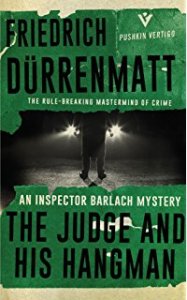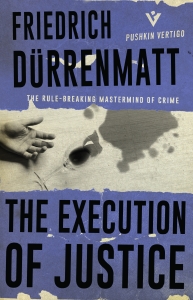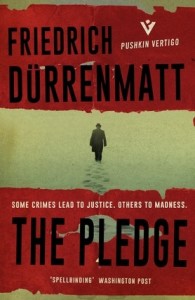The Judge and his Hangman – Friedrich Dürrenmatt
 Friedrich Dürrenmatt, the author of ‘The Judge and his Hangman’, did not have a high opinion of what he regarded as traditional crime fiction. He was a renowned Swiss dramatist active between the late 1940s and the 1980s, an early proponent of ‘epic theatre’, of which Bertolt Brecht was the most influential author.
Friedrich Dürrenmatt, the author of ‘The Judge and his Hangman’, did not have a high opinion of what he regarded as traditional crime fiction. He was a renowned Swiss dramatist active between the late 1940s and the 1980s, an early proponent of ‘epic theatre’, of which Bertolt Brecht was the most influential author.
Besides a host of successful plays, Dürrenmatt wrote several novels, most of them, curiously, with a crime fiction flavour. He was actually interested enough in the genre to want to write his very own brand of detective story, producing a handful of superbly crafted novels which Pushkin Press is publishing, translated by Joel Agee, under its Vertigo imprint.
‘The Judge and his Hangman’ was one of the very first Dürrenmatt wrote, introducing Inspector Barlach, a character that will feature in subsequent stories too. He created Barlach roughly at the same time when Mickey Spillane’s hard-boiled hero Mike Hammer was getting into the swing of things, and when Georges Simenon’s Commissaire Maigret had already achieved legend status. I mention Maigret because Barlach, though different from him in some respects, is cast in much the same mould as the Parisian investigator: a career police detective, unglamorous but persistent, one of the many who took over from the inspired amateur sleuths and callous PIs of the 1920s, 30s and 40s as the archetypal lead investigator. And I mention Hammer because Barlach (as is Maigret) is as distant a character from the all-action, tough-guy Hammer as possible, further proof of Dürrenmatt’s quirky authorial contrariness.
Barlach is in his sixties, and – so we are led to think – severely ill with cancer. For the Bern-based Swiss police inspector, the murder of his colleague Schmied, killed by two point-blank gunshots as he was returning from a society party, could well be one of the last cases. Barlach is paired off with a younger, promotion-hungry detective called Tschanz, and they immediately uncover a puzzling fact: Schmied was regularly attending the parties thrown by wealthy, reclusive Herr Gastmann in his mansion in the mountains, blending in with wealthy industrialists and foreign diplomats, but was doing so under a fictitious name.
Barlach tells his boss, Dr Lutz, that he has no idea what Schmied was up to, and visits the dead man’s lodgings, picking up a dossier the murdered detective was apparently working on. And whose existence he hides from Dr Lutz and eager-beaver Tschanz.
It is the first of several misdirections by the gruff inspector. Though chided by Dr Lutz for being old-fashioned –like most of the Bern police corps – and lamentably out of touch with modern (meaning American) policing methods, Barlach plays a constant game of hide-and-seek with his superior, with Tschanz and of course the readers. Dürrenmatt’s delight in springing these surprises is evident. Throughout the novel, Barlach/ Dürrenmatt are as unreliable a character/narrator pair as you will find in contemporary crime fiction, and fill the narrative with enough cleverly concealed twists to make it highly satisfactory.
Despite Barlach’s unorthodox methods, not to mention the quaint out-of-datedness which pervades the novel, it is hard not to be drawn to ‘The Judge and his Hangman’. It was originally published in 1950, so readers must forget about high-tech CSI work or adrenalin-pumping chases, and even allow for the presence of a Dr Moriarty-type character. What makes ‘The Judge and his Hangman’ a brilliant story though, besides the tension Dürrenmatt is able to infuse the narrative with, is the Swiss author’s impeccable sense of narrative timing and his razor-sharp characterisation and scene-setting. In a slim, 124-page novel, he crams a wealth of observation and a multi-faceted cast of characters many of his colleagues would need twice as much space to write about as effectively as he does.
Just as the idyllic mountainscape of the Bernese Oberland is aptly sketched by Dürrenmatt in economical, deft strokes, so are the story’s protagonists – Barlach, Tschanz, the straight-jacketed, bureaucratic Dr Lutz, the enigmatic Gastmann and his mellifluous lawyer von Schwendi, and a host of ‘minor’, but no less cleverly rendered, ones.
‘The Judge and his Hangman’ is, exactly as Dürrenmatt intended I believe, a detective story that gladly upends some of the genre’s stereotypes. It is a tribute to Dürrenmatt’s huge literary talent that this holds true even if looked at from a contemporary perspective. Pushkin Press are planning to print other Dürrenmatt ‘crime’ novels, so we can only look forward to them and to their nerve-tingling, pared-down sophistication with pleasure.





